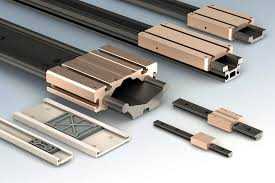Linear actuators are vital components in a wide range of applications, from industrial machinery and robotics to consumer products and automotive systems. These devices convert rotational motion into linear motion, enabling precise control over movement and positioning. This comprehensive guide delves into the fundamentals of linear actuators, including their types, applications, benefits, and key considerations for selection.

What is a Linear Actuator?
A linear actuator is a mechanical device that creates linear motion from an initial rotary input. Unlike rotary actuators, which produce rotational movement, linear actuators offer movement in a straight line. This functionality is essential for applications that require exact positioning, push-pull actions, or lifting and lowering tasks.
Types of Linear Actuators
1. Electric Linear Actuators
Electric linear actuators use an electric motor to drive the movement. They are known for their precision and ease of control.
Features:
- Electric Motor: Converts electrical energy into mechanical motion.
- Lead Screws or Ball Screws: Translates rotary motion into linear motion.
- Control Options: Can be controlled via switches, remotes, or automated systems.
Benefits:
- High Precision: Offers accurate and reliable movement.
- Ease of Integration: Can be easily integrated into existing systems.
- Programmable: Allows for customizable control settings and automation.
2. Hydraulic Linear Actuators
Hydraulic linear actuators use hydraulic fluid to generate movement. They are well-suited for high-force applications.
Features:
- Hydraulic Cylinder: Uses fluid pressure to create linear force.
- Pumps and Valves: Manage the flow of hydraulic fluid.
- Heavy-Duty Construction: Designed to handle large loads.
Benefits:
- High Force Output: Ideal for heavy-duty applications.
- Smooth Operation: Provides consistent and controlled movement.
- Durability: Built to withstand demanding conditions.
3. Pneumatic Linear Actuators
Pneumatic linear actuators use compressed air to produce movement. They are often used in applications requiring rapid, repeated motions.
Features:
- Pneumatic Cylinder: Utilizes air pressure for linear motion.
- Compressor Required: Needs a source of compressed air.
- Adjustable Speed: Allows for variable speed control.
Benefits:
- Fast Movement: Capable of quick and repetitive actions.
- Cost-Effective: Generally less expensive than hydraulic actuators.
- Lightweight: Suitable for applications with weight constraints.
4. Mechanical Linear Actuators
Mechanical linear actuators use mechanical means such as gears and levers to create motion. They are simple and robust.
Features:
- Gears and Levers: Translate rotary motion into linear movement.
- Manual Operation: Can be operated manually or motorized.
- Durable Design: Often used in rugged environments.
Benefits:
- Simplicity: Straightforward design with fewer components.
- Reliability: Minimal risk of failure due to fewer moving parts.
- Cost-Efficient: Generally lower cost compared to other types.
Applications of Linear Actuators
1. Robotics
In robotics, linear actuators are used to control the movement of robotic arms, grippers, and other components. Their precision is crucial for tasks such as assembly, manipulation, and inspection.
2. Industrial Automation
Linear actuators play a significant role in industrial automation, where they are used in conveyor systems, automated manufacturing processes, and machinery. They provide reliable movement and positioning for efficient production.
3. Automotive Systems
In automotive applications, linear actuators are used for functions such as power seats, adjustable mirrors, and trunk lifts. They contribute to convenience and comfort in modern vehicles.
4. Medical Devices
Medical devices such as hospital beds, surgical tables, and prosthetics utilize linear actuators for precise adjustments. Their ability to provide controlled movement enhances patient care and equipment functionality.
5. Consumer Electronics
In consumer electronics, linear actuators are used in devices like projectors, camera sliders, and adjustable stands. They enable smooth and precise adjustments for improved user experience.
Benefits of Linear Actuators
1. Precision and Accuracy
Linear actuators offer precise control over linear movement, making them ideal for applications requiring exact positioning and fine adjustments. This precision is crucial in fields such as robotics, medical devices, and manufacturing.
2. Versatility
Linear actuators are versatile and can be used in a wide range of applications, from industrial machinery to consumer electronics. Their ability to perform various functions makes them valuable components in many systems.
3. Ease of Control
Many linear actuators come with advanced control options, including electronic controls, remote operation, and automation capabilities. This ease of control enhances their usability and integration into complex systems.
4. Durability and Reliability
Designed to withstand demanding conditions, linear actuators are built from high-quality materials to ensure long-term reliability. Their durability makes them suitable for use in harsh environments and continuous operations.
Key Considerations When Choosing a Linear Actuator
1. Load Capacity
Determine the load capacity required for your application. Different linear actuators offer varying levels of force, so choose one that can handle the necessary load without compromising performance.
2. Speed and Stroke Length
Consider the speed at which the actuator needs to move and the stroke length required for your application. Ensure that the actuator you select meets these specifications for optimal performance.
3. Control Mechanism
Evaluate the control options available for the actuator, including manual, electric, hydraulic, or pneumatic controls. Choose a system that aligns with your requirements and integration needs.
4. Environment and Conditions
Assess the operating environment and conditions, such as temperature, humidity, and exposure to chemicals or dust. Select an actuator that can withstand these conditions and maintain reliable operation.
5. Cost and Budget
Consider your budget and compare the costs of different linear actuators. While higher-quality actuators may come with a higher price tag, their durability and performance can offer long-term value.
linear motion actuator https://www.progressiveautomations.com/collections/linear-actuators are indispensable components in various applications, offering precise control, versatility, and reliability. By understanding the different types of linear actuators, their applications, and key considerations for selection, you can make informed decisions when integrating these devices into your systems. Whether you're working on industrial automation, robotics, medical devices, or consumer electronics, linear actuators provide the precision and functionality needed for success. Investing in the right linear actuator enhances performance, efficiency, and overall user experience in your projects.







